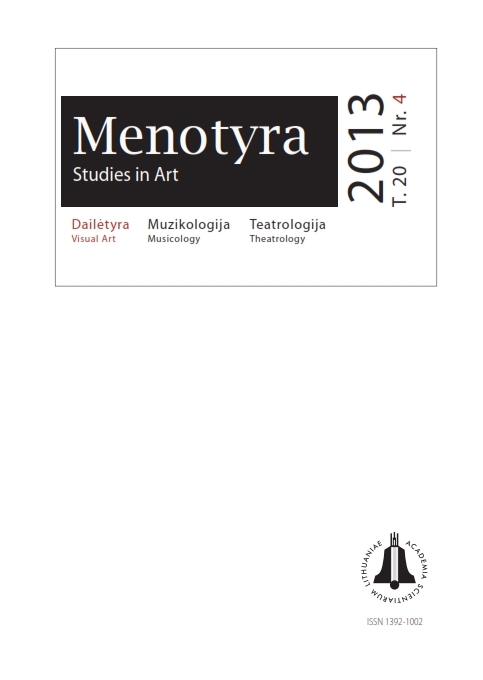Lietuvos paviljonas Londono parodoje 1968 m.
Lithuanian pavilion at the London Exhibition in 1968
Author(s): Karolina JakaitėSubject(s): Fine Arts / Performing Arts, Visual Arts
Published by: Lietuvos mokslų akademijos leidykla
Keywords: international exhibitions in the Soviet period; Cold War modernity; graphic design; Experimental Artistic Construction Bureau; Swiss International Typographic Style; appropriation and postmodernism;
Summary/Abstract: The paper is based on the case study analysis dedicated to the Soviet Union Industry and Trade Exhibition that was held in London at the Earls Court Exhibition Centre in 1968, where Lithuania had a national stand with an integrated artistic concept. The case study analyses the material related to the Exhibition by using complex research methods, interviews with artists and participants of the exhibition, archival sources in Lithuania and abroad, insights of Lithuanian and foreign authors. An in-depth analysis reveals that Lithuania’s presentation in London in 1968 was modern and Western in its form (integrated concept of the exhibition, exposition design, a series of in formational and representative publications, promotional films, specially created ambitious works of art, kinetic stained glass, avant-garde electro acoustic music, collections of the newest furniture and luxury items, nude photography) and national in its content (Lithuanian titles of works, Lithuanian trademarks, patriotic themes, images and symbols). The London Exhibition, as well as many other export exhibitions, was organized by the LSSR Exhibition of Achievements of the National Economy. Young artists, among them architect and designer Tadas Baginskas, stainedglass artist Algimantas Stoškus, graphic designers Vaidilutė Grušeckaitė and Antanas Kazakauskas,composer Feliksas Bajoras, were invited to implement the project of the Lithuanian pavilion at the London Exhibition. Representation of the London Exhibition and especially Lithuanian pavilion clearly highlighted the context of the Cold War competition: it was sought to show the maximum of modernity keeping pace with the West.The catalogue of the London Exhibition Lithuania. London, 68 created by A. Kazakauskas canbe considered the most modern of all Lithuanian representative publications of the Soviet period that has no analogues. Its remarkably free typographic language, interpretations of international styles, particularly Swiss International Typographic Style and ingeniously applied principles of citation and appropriation of other Lithuanian graphic artists’ works make it one of the first examples of post-modern graphic design.The series of advertising graphic design publications created for the London Exhibition as well as the catalogue Lithuania. London, 68 were not spread in the country and their reception was limited to the private space of artists and people related to the Exhibition. On the other hand,it can be assumed that they were “not sought to be noticed” especially in Soviet years because of extremely brave typographic language, shades of satire and irony present in visual and textual compositions. Generally, evaluations of the London Exhibition were highly affected by the Prague events started by the invasion of the Soviet army to Czechoslovakia on the night of 21 August 1968.To summarize the case study research, it can be said that the 1968’ London Exhibition was one of the most conceptual and large-scale presentations of Lithuania in the West during the Cold War era and that it perfectly embodied and responded to the challenges of the Cold War modernity competition.
Journal: Menotyra
- Issue Year: 20/2013
- Issue No: 4
- Page Range: 302-323
- Page Count: 22
- Language: Lithuanian

